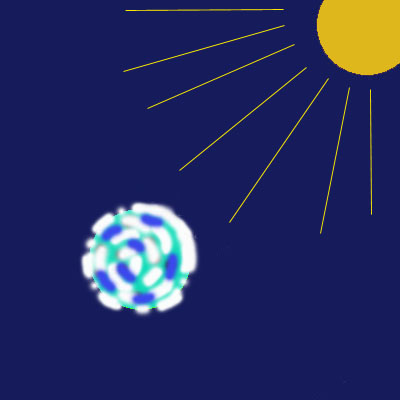de-2013.10.31 / Apr. 2, 2022
A drop of seawater
One drop of seawater to bring a planet to life
Very many cannot imagine how quickly you can infect a lifeless, sterile planet with life.
I keep thinking: How can you bring a "new", sterile planet, which is at the right distance from its central star, to life? I see this in connection with a generation spaceship.
If the temperature is right, and assuming that the planet rotates on its own axis, it is very easy to do. Put a drop of our seawater in one of its oceans and within a year you have enough oxygen for wildlife all over the planet. Assuming, of course, that there is still enough volcanic activity to produce CO2. Because without CO2 there is no photosynthesis and therefore no oxygen.
Ah, I forgot to tell you: 80-90% of the earth's oxygen comes from algae in waters and not from terrestrial plants.
Explanation and assumptions
For example: Let's assume that our sun is slowly running out of "fuel". I emphasise: "slowly". That means that later, for several hundred million years, we would have a Venus with the right temperature. The water that Venus now harbours in its very hot atmosphere would precipitate to the bottom and form huge bodies of water. Now I see the following sequence:
1. today's Venus
|
Today's Venus is a very hot planet whose atmosphere consists of 95% CO2. CO2 is produced by volcanic activity. CO2 is the most important gas that our botanical life on Earth needs. Due to the heat of the sun's rays and the heat coming from the interior of Venus, the soil of Venus reaches a temperature of over 400 ° C. This makes the soil slightly reddish. This makes the soil slightly reddish and even tin becomes liquid on it. The storms on Venus reach wind speeds of up to 350 km/h. |
 |
2. tomorrow's Venus as an example
|
In a few hundred million years, the sun and the interior of Venus will have cooled down considerably. The storms will have subsided as a result. The water and other - formerly gaseous - substances will then have settled and formed bodies of water. The acids will have bound themselves and now sterile seas will be formed without any life. Now I claim that a single drop of our "present-day" sea water would be enough to give Venus an air atmosphere with sufficient oxygen in a single year. I would like to explain below how this is supposed to work. |
 |
3. the cell division of the seaweed
If we assume that cell division - in the case of simple single-celled organisms (algae) - takes place every few hours, then this results in an enormous number of cells in 120 days. These 120 days correspond roughly to one solar day on Venus. Venus rotates slowly on its own axis, and so this sunshine duration should have an uninterrupted effect for 120 days.
Now let's calculateAssumption: |
 in 16 hours |
This results therefore in 120 x 3 = 360 "doublings".
The calculation is now easy:
2360 = planet-covering number of unicellular algae.
Die Photosynthese nochmals erläutert:
6 H2O + 6 CO2 + Licht = 6 O2 + C6H12O6
With that we would have solved the oxygen problem. On a planet where the temperature is right and there is enough CO2 (carbon dioxide), it is possible to create an air envelope with oxygen within a single year. This is done with the help of unicellular seaweed. As long as the volcanic activity is still active to a sufficient extent (as on Earth), the algae will be able to produce enough oxygen from the CO2. Otherwise, one can double up with unicellular, zoological bacteria that produce CO2.